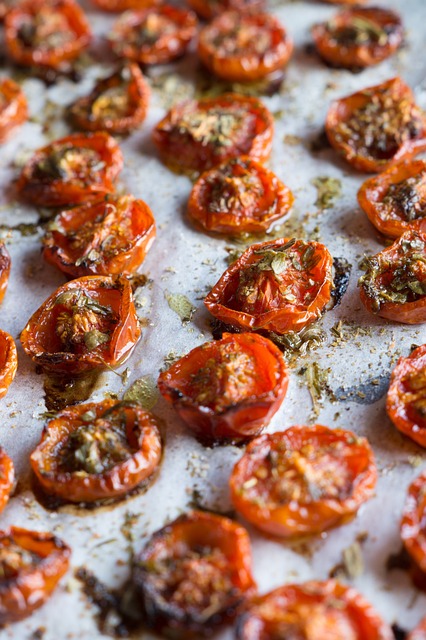Mastering Kitchen Cutting and Chopping Techniques with Essential Tools
Kitchen
Mastery of kitchen cutting and chopping is essential for efficient meal preparation and enhancing dish presentation. A well-equipped chopping station includes durable cutting boards, a sharp chef's knife or paring knife, specialized tools like slicers and dicers, and a separate cutting mat to protect countertops. Learning standard cuts such as dicing, julienning, brunoise, and batonnet, along with correct knife handling techniques for safety and precision, is crucial. Utilizing different cutting boards for various food items prevents cross-contamination and is a hygiene best practice. By mastering these skills and utilizing the right tools, kitchen cutting and chopping can be elevated from a basic task to an art form that significantly contributes to a memorable culinary experience. The introduction of modern tools like mandolines and electric choppers has advanced efficiency and precision in food preparation, with smart technology offering user-friendly features for enhanced control and support in the kitchen cutting and chopping process. Regular knife maintenance, including sharpening and proper care, is key to ensuring safety and effectiveness in these tasks.
knife skills are the cornerstone of efficient cooking, transforming fresh ingredients into the basis of flavorful dishes. This article delves into the essentials of kitchen cutting and chopping, guiding you through the process of setting up a chopping station, mastering fundamental cuts like julienne, dice, and brunoise, and maintaining your tools to keep them in optimal condition. Discover how innovative tools can elevate your chopping game, making your preparation time not only safer but also swifter. Whether you’re a home cook or a seasoned chef, enhancing your kitchen cutting and chopping techniques will undoubtedly enrich your culinary repertoire.
- Understanding the Essentials of Kitchen Cutting and Chopping
- The Anatomy of a Well-Equipped Chopping Station
- Mastering Fundamental Cuts for Versatile Cookery
- – The Basics: Julienne, Dice, Brunoise, and Beyond
- Sharpening the Art of Cutting: Keeping Your Tools in Prime Condition
- Innovative Tools that Transform Chopping into an Efficient Practice
Understanding the Essentials of Kitchen Cutting and Chopping
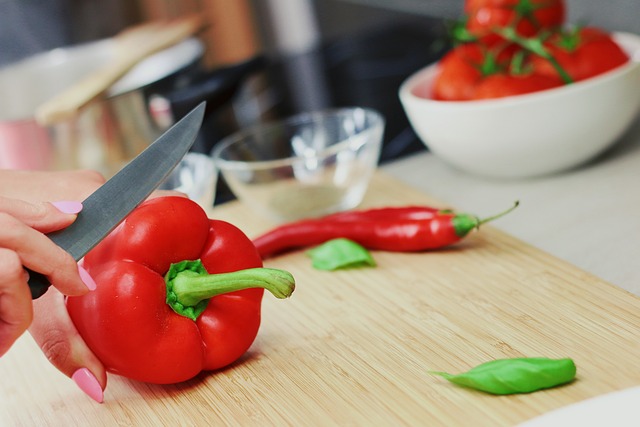
kitchen cutting and chopping techniques are fundamental skills for any home cook or professional chef, enhancing both the culinary experience and meal presentation. To master these skills, one must familiarize themselves with a variety of tools designed specifically for different cutting tasks. A sharp chef’s knife is undoubtedly the most versatile tool in any kitchen, suitable for chopping vegetables, slicing meats, and mincing herbs with precision and ease. Complementing this essential knife, a set of paring knives comes in handy for more delicate work such as peeling fruits or trimming delicate ingredients. Additionally, kitchen shears are indispensable for snipping herbs and cutting poultry or seafood into manageable pieces. For safety and efficiency, it’s crucial to maintain the sharpness of these tools and to use them correctly to minimize accidents and maximize food quality.
Incorporating the right methods with the appropriate tools is key to successful kitchen cutting and chopping. A rocker knife hand motion, for instance, provides a more natural cutting action compared to pushing the blade through ingredients. Dicing, julienning, brunoise, and batonnet are standard cuts that add variety and flair to dishes, each requiring specific techniques and knife sizes. Understanding how to hold a knife properly and how to position your fingers for safety is also paramount. Moreover, cutting boards of different materials like bamboo or plastic serve diverse purposes, such as chopping vegetables on one board and cutting meats on another to prevent cross-contamination. By honing these skills and utilizing the right tools, kitchen cutting and chopping become not just a routine task but an art form that elevates the culinary experience for both the cook and the diner.
The Anatomy of a Well-Equipped Chopping Station
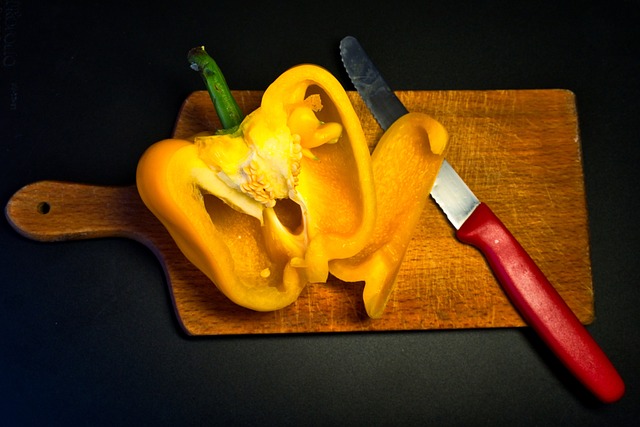
A well-equipped chopping station in the kitchen is a testament to efficiency and safety in culinary preparation. Central to this setup is a sturdy cutting board, often made of bamboo, glass, or plastic, chosen for its resistance to wear and hygienic properties. Adjacent to the cutting board, a sharp chef’s knife or a paring knife for precise work sits ready, its edge meticulously maintained for clean cuts that minimize waste and maximize safety. The station may also include specialized tools such as a slicer, a dicing tool, or a mandoline for uniformity in presentation and cooking. A cutting mat, different from the chopping board, might be employed below to protect the countertops from blade marks and facilitate easy cleanup. Additionally, strainers or colanders are often within arm’s reach to rinse vegetables or catch juices. A variety of knife sharpeners ensures that each blade is in optimal condition, while a set of kitchen scales provides precise measurements for ingredients. Proper lighting and ample ventilation contribute to the functionality of the station, making it a versatile and comfortable space for any kitchen cutting and chopping tasks. With attention to detail and the right tools at hand, this station becomes an extension of the chef’s skill, enhancing the efficiency and quality of meal preparation.
Mastering Fundamental Cuts for Versatile Cookery

Mastery of fundamental cuts is a cornerstone in versatile cookery, allowing for a wide array of culinary possibilities. In the kitchen cutting and chopping arena, understanding how to execute precise cuts is not merely about technique; it’s an art that transforms raw ingredients into the building blocks of flavorful dishes. The basic cuts—dice, brunoise, julienne, batonnet, and chiffonade—are foundational. A dice, for instance, is a cube-shaped cut crucial for stews and soups, where each ingredient has an equal surface area to flavor the liquid. Moving to the julienne, this long, thin strip is perfect for adding crunch and texture to salads or stir-fries. Each slice, whether fine or broad, must be uniform to ensure even cooking and consistent presentation. The chiffonade, a delicate ribbon cut for herbs like basil or spinach, releases their flavors without overwhelming the dish. To master these cuts, one must acquaint themselves with various knives, from the versatile chef’s knife to the paring knife, each suited for different tasks in kitchen cutting and chopping processes. Additionally, using proper cutting boards and maintaining a sharp blade are essential practices that enhance precision and safety. As you become proficient in these cuts, you’ll find they form the basis of efficient meal preparation, opening up a world of culinary creativity and versatility in your cookery.
– The Basics: Julienne, Dice, Brunoise, and Beyond
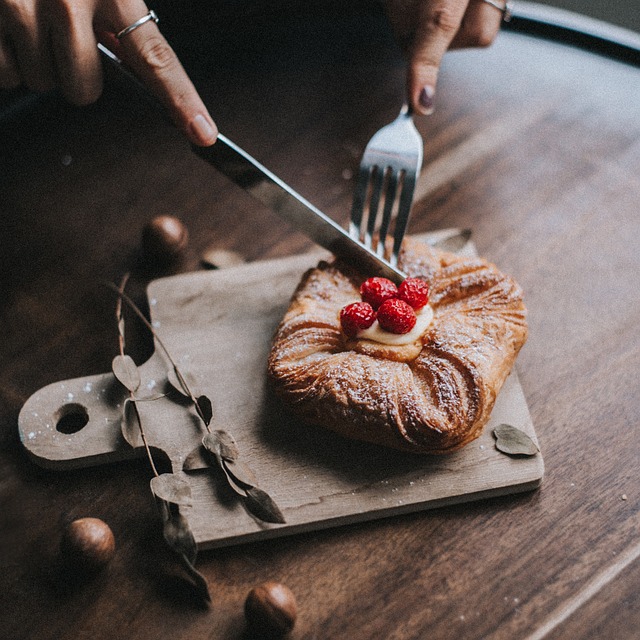
Kitchen cutting and chopping are fundamental skills that form the backbone of efficient meal preparation. These techniques not only enhance the presentation of dishes but also ensure even cooking by providing uniform-sized ingredients. Among the most basic and commonly used methods are julienne, dice, and Brunoise cuts.
To begin with, ‘julienne’ refers to cutting vegetables or fruits into thin, 1/8-inch wide strips. This technique is particularly suited for items like carrots, cucumbers, and zucchini that can be sliced lengthwise or crosswise to achieve the desired shape. Moving on to ‘dice,’ this method involves cutting an item into cubes of equal size, typically 1/2 inch on each side. Dicing is versatile and suitable for a variety of ingredients, including tomatoes, onions, and potatoes. The ‘Brunoise’ cut takes the dice a step further by finely dicing vegetables into tiny, 1/4-inch cubes. This intricate process is labor-intensive but yields a uniform consistency that is essential in dishes where texture and even cooking are critical.
Beyond these classical techniques, there are various other cuts like ‘brunoise fine,’ which are even smaller than the traditional Brunoise, and ‘julienne matchsticks,’ which are thinner and shorter than regular julienne cuts. Mastery of these cutting methods is essential for any cook aiming to elevate their kitchen chopping skills. Whether it’s preparing a salad or creating a complex dish, understanding the nuances of each cut can significantly impact the outcome of your culinary endeavors. Kitchen cutting and chopping tools such as knives, mandolines, and slicers can assist in achieving precision and consistency across these techniques.
Sharpening the Art of Cutting: Keeping Your Tools in Prime Condition

When it comes to kitchen cutting and chopping, the sharpness of your tools plays a pivotal role in both efficiency and safety. A well-maintained knife glides through produce with minimal effort, ensuring precision cuts every time. Regular sharpening is an art form that transforms a blunt blade into a finely tuned instrument for culinary tasks. To maintain the prime condition of your cutting tools, it’s crucial to understand the different methods available for sharpening. Traditional stone sharpening, for instance, requires skill and practice but can produce exceptionally sharp edges. Alternatively, electric sharpeners offer a user-friendly alternative that can quickly restore the edge of kitchen knives. Regardless of the method chosen, consistent maintenance is key. Dull knives can cause frustration, waste, and even injury, making the act of keeping your tools sharp not just a matter of preference but a critical aspect of kitchen safety and skill. In addition to sharpening, proper knife care includes cleaning and storing them correctly to prevent rust and damage. By investing time in the maintenance of your cutting tools through regular sharpening and careful handling, you elevate your kitchen cutting and chopping skills, transforming routine tasks into elegant and efficient culinary practices.
Innovative Tools that Transform Chopping into an Efficient Practice
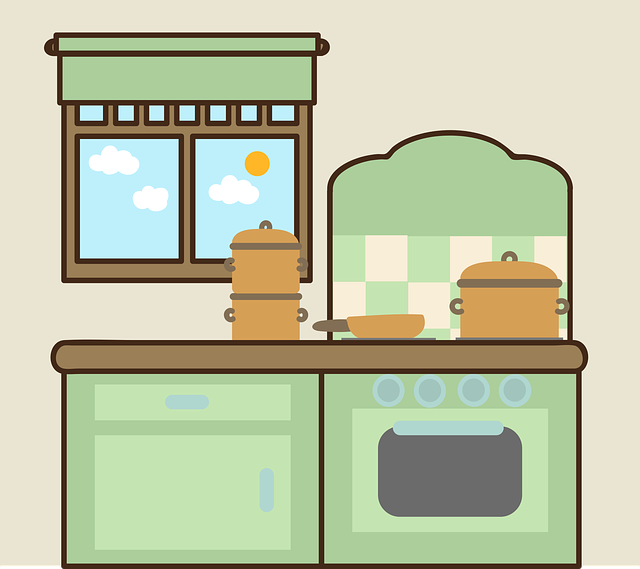
Kitchen cutting and chopping tasks have evolved with the advent of innovative tools that significantly enhance efficiency and precision in food preparation. The traditional chef’s knife remains a staple, but modern kitchens are integrating a host of gadgets designed to streamline the process of transforming raw ingredients into culinary masterpieces. For instance, mandolines offer a precise slicing capability that is perfect for uniform vegetable cuts or delicate fruit arrangements. With adjustable blades and guarded fingers, these tools eliminate the need for constant knife sharpening and reduce the risk of injury.
Moreover, electric choppers and food processors have become indispensable in the kitchen cutting and chopping arsenal. These appliances range from compact handheld devices suitable for mincing herbs to robust countertop models that can handle larger batches with a variety of attachments for diverse textures and cuts. Features such as programmable settings, pulse modes, and dishwasher-safe parts make these electric options not only efficient but also convenient to use and maintain. The integration of kitchen cutting and chopping tools with smart technology, like Bluetooth connectivity or app-based recipe guidance, further elevates the experience by providing users with additional control and assistance, thus transforming the act of chopping into a seamless and enjoyable task.
mastery of knife skills enhances culinary creativity, transforming simple ingredients into gourmet delights. A well-equipped chopping station, complete with essential tools and innovative aids, forms the cornerstone of efficient preparation. By honing the ability to execute fundamental cuts like julienne, dice, and brunoise, one unlocks the potential for diverse cooking ventures. Regular maintenance and sharpening of cutting tools ensure they remain precise instruments for any chef. In essence, whether you’re a novice or an expert in the kitchen, mastering cutting and chopping techniques is key to elevating your culinary artistry. Kitchen cutting and chopping are not mere tasks but foundational skills that every cook should cultivate for both functionality and flavor enhancement.
